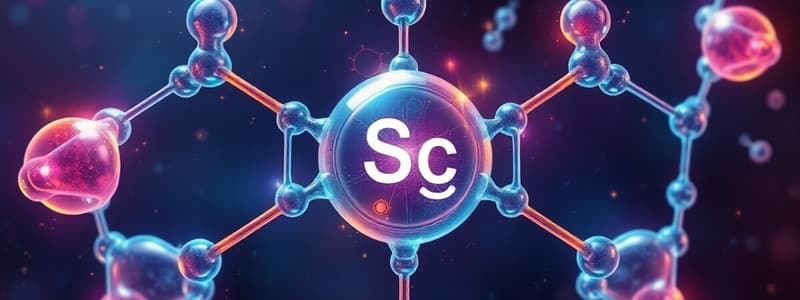Podcast
Questions and Answers
How many elements exist naturally among the first 98?
How many elements exist naturally among the first 98?
- 100
- 50
- 98 (correct)
- 80
All of the first 98 elements are commonly found in large quantities in nature.
All of the first 98 elements are commonly found in large quantities in nature.
False (B)
What is the status of elements that exist only in trace amounts among the first 98?
What is the status of elements that exist only in trace amounts among the first 98?
They were initially discovered by synthesis in laboratories.
The first 98 elements exist naturally, although some were initially discovered through __________ in laboratories.
The first 98 elements exist naturally, although some were initially discovered through __________ in laboratories.
Match the following terms related to the first 98 elements:
Match the following terms related to the first 98 elements:
What occurs during the formation of an ionic bond?
What occurs during the formation of an ionic bond?
Ionic bonds are a type of covalent bond.
Ionic bonds are a type of covalent bond.
Name two types of atoms involved in ionic bonding.
Name two types of atoms involved in ionic bonding.
An ionic bond is formed when an electron is transferred from a(n) ______ atom to a(n) ______ atom.
An ionic bond is formed when an electron is transferred from a(n) ______ atom to a(n) ______ atom.
Match the following terms related to ionic bonds:
Match the following terms related to ionic bonds:
Flashcards are hidden until you start studying
Study Notes
Naturally Occurring Elements
- The first 98 elements exist naturally, although some are only found in trace amounts.
- Some elements were initially discovered through laboratory synthesis.
Ionic Bonds
- An ionic bond forms through the transfer of an electron from an electropositive atom to an electronegative atom.
- The resulting ions are attracted to each other by electrostatic forces.
- Sodium chloride (NaCl) provides a simple example of an ionic bond.
sp2 Orbitals
- sp2 orbitals are formed when one s and two p orbitals combine to form three equivalent sp2 hybrid orbitals.
- These orbitals are located in the same plane and are oriented at 120° angles, forming a triangular shape.
Topical Agents
- Topical agents are substances applied to the skin or mucous membranes.
- Some topical agents have antibacterial properties.
- Acidifying a solution can increase the effectiveness of antibacterial agents.
- Aluminum chloride is a common ingredient in deodorant products.
- Aluminum chloride can cause skin irritation, so alternative ingredients like aluminum zirconium are often used.
Studying That Suits You
Use AI to generate personalized quizzes and flashcards to suit your learning preferences.



